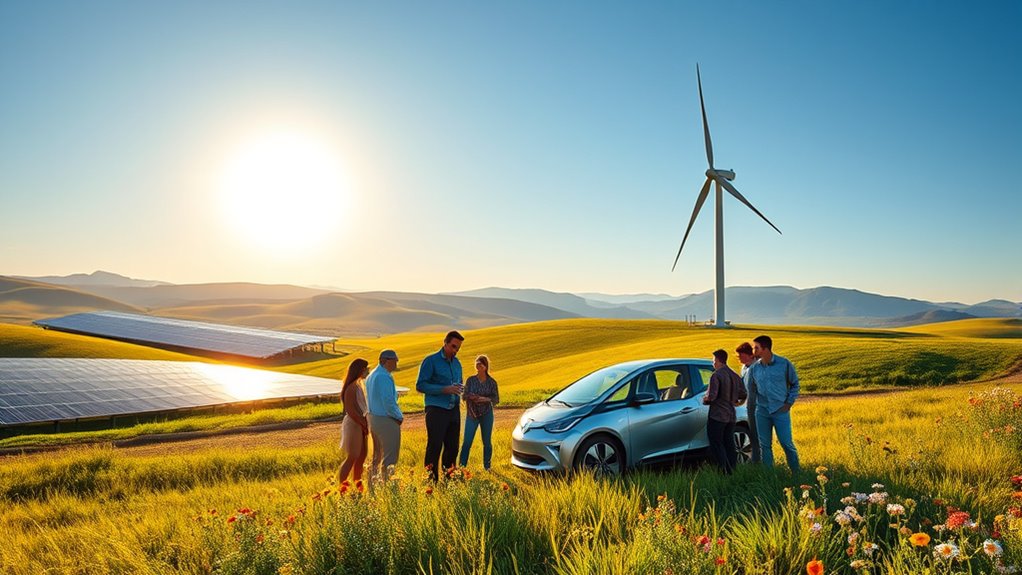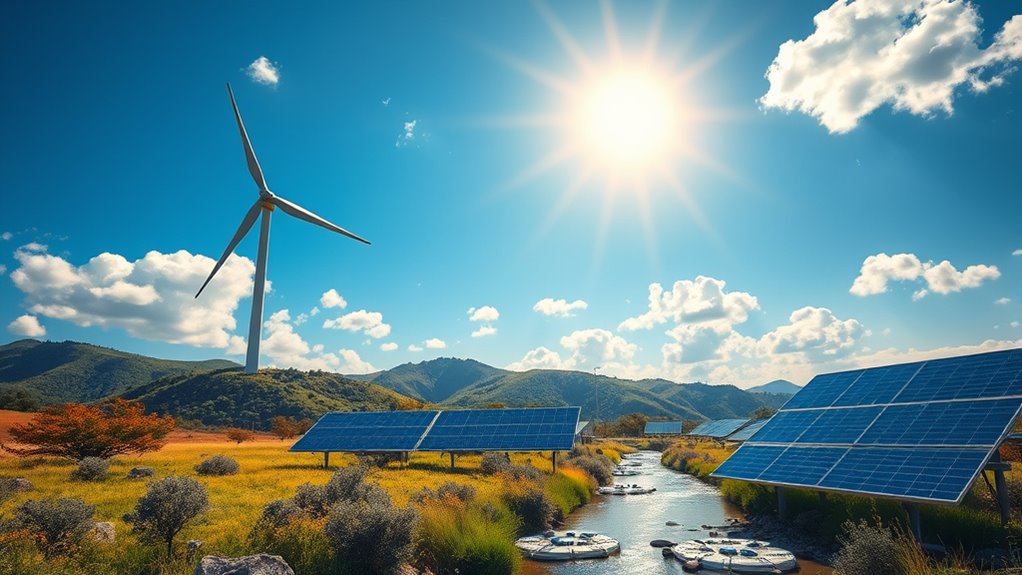Green tech innovations are changing how you use energy and grow food, making a positive impact on the planet. By harnessing renewable sources like solar and wind, you reduce your reliance on fossil fuels. Smart farming techniques boost crop yields while conserving resources. You can also support sustainable practices in your community. The move towards a cleaner, greener future is happening now, and there’s so much more to explore about these exciting technologies.
Key Takeaways
- Renewable energy technologies like solar and wind power significantly reduce carbon footprints and reliance on fossil fuels, promoting a cleaner environment.
- Smart farming innovations utilize data analytics and precision agriculture to optimize resources, boosting crop yields while minimizing environmental impacts.
- Integrating renewable energy systems into farming, such as solar panels and wind turbines, lowers operational costs and supports sustainable agricultural practices.
- Collective actions, like supporting renewable energy policies and choosing sustainable produce, empower individuals to contribute to a more resilient and eco-friendly future.
- Innovative green technologies are paving the way for a low-carbon economy, enabling cleaner energy solutions that benefit both the planet and communities globally.

Have you ever wondered how technology can help save our planet? You’re not alone in this curiosity. With the pressing issues of climate change and environmental degradation, innovative green technologies are stepping up to the plate. One of the most exciting developments is in the domain of renewable energy. Imagine harnessing the power of the sun, wind, and water to meet our energy needs. This isn’t just a dream; it’s a reality that’s gaining momentum. By investing in solar panels, wind turbines, and other sustainable sources, you’re not only reducing your carbon footprint but also contributing to a cleaner, greener future.
Innovative green technologies are turning dreams of renewable energy into a reality, paving the way for a cleaner, greener future.
Now, let’s talk about sustainable agriculture. The way we produce food is at a critical juncture, and technology plays a pivotal role in transforming this sector. One of the key aspects of sustainable agriculture is using data analytics and smart farming techniques. These innovations allow farmers to monitor crop health in real-time, optimize water usage, and reduce waste. For instance, precision agriculture utilizes GPS technology and sensors to determine the exact needs of each crop. By applying water, fertilizers, and pesticides more efficiently, you can considerably decrease environmental impact while boosting yields.
Moreover, integrating renewable energy sources into farming practices is another way technology is reshaping the landscape. Solar panels on barns or wind turbines on farms can provide the energy needed for operations, reducing reliance on fossil fuels. When you think about it, this not only lowers costs for farmers but also promotes a sustainable ecosystem. By choosing to support practices that prioritize renewable energy and sustainable agriculture, you’re making a conscious decision to protect the planet.
The synergy between renewable energy and sustainable agriculture is essential for a resilient future. As you embrace these technologies, you’re not just witnessing a shift; you’re part of it. Every small action—whether it’s choosing organic produce, advocating for renewable energy policies, or even just educating yourself and others—contributes to a larger movement.
Frequently Asked Questions
What Are Some Examples of Green Tech Startups?
Some great examples of green tech startups include companies like Tesla, which focuses on sustainable transportation with electric vehicles, and Sunrun, specializing in renewable energy through solar installations. You might also check out Rivian, known for its electric trucks and SUVs, or ChargePoint, which develops charging networks for electric vehicles. These startups are leading the charge in creating a more sustainable future and making a real impact on environmental efforts.
How Can Individuals Support Green Technology Initiatives?
You can support green technology initiatives by making personal investments in eco-friendly startups and participating in community engagement activities. It’s ironic how a simple act, like choosing a reusable bag, can spark a chain reaction in your neighborhood. Attend local workshops or join online forums to spread awareness. Your small contributions can lead to a larger impact, proving that every effort counts in creating a sustainable future. So, get involved and inspire others!
What Are the Costs Associated With Green Tech Innovations?
The costs associated with green tech innovations can be significant. You might face financial barriers such as high initial investments and ongoing maintenance expenses. Additionally, resource allocation becomes essential; deciding where to invest can impact your overall budget. While these costs can seem intimidating, they often lead to long-term savings and environmental benefits. By carefully planning and prioritizing your spending, you can effectively navigate the financial aspects of adopting green technologies.
How Does Green Technology Impact Job Creation?
Think of green technology as a garden blooming with opportunities. It creates sustainable employment by fostering eco-friendly careers that thrive in various sectors. As industries shift towards renewable energy and sustainable practices, you’ll find a growing demand for skilled workers in areas like solar energy, waste management, and green building. This transformation not only helps the planet but also opens doors for you to contribute to a healthier environment while securing a fulfilling job.
What Challenges Does Green Technology Face in Implementation?
Green technology faces several challenges in implementation, including policy barriers and funding obstacles. You might encounter regulations that hinder innovation or lack consistent government support for green initiatives. Additionally, securing investment can be tough, as many investors remain skeptical about long-term returns. These issues often slow down the development and adoption of sustainable solutions. To overcome these hurdles, collaboration among stakeholders and proactive policy changes are essential for driving progress in green technology.
Conclusion
As you explore the impact of green tech innovations, consider this: by 2030, renewable energy sources are projected to power over 50% of the world’s electricity. Just imagine the vibrant landscapes filled with solar panels and wind turbines, transforming our energy landscape and reducing our carbon footprint. It’s not just a dream; it’s a reality within reach. By embracing these technologies, you’re not only helping the planet but also paving the way for a sustainable future for generations to come.










